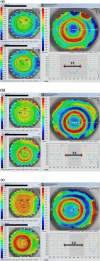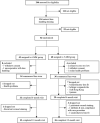One-year results of the Variation of Orthokeratology Lens Treatment Zone (VOLTZ) Study: a prospective randomised clinical trial
- PMID: 33991112
- PMCID: PMC8251614
- DOI: 10.1111/opo.12834
One-year results of the Variation of Orthokeratology Lens Treatment Zone (VOLTZ) Study: a prospective randomised clinical trial
Abstract
Purpose: To present the 1-year results of the Variation of Orthokeratology Lens Treatment Zone (VOLTZ) Study, which aims to investigate the myopia control effect of orthokeratology (ortho-k) lenses with different back optic zone diameters (BOZD).
Method: Children, aged 6 to <11 years, having myopia -4.00 D to -0.75 D, were randomly assigned to wear ortho-k lenses with 6 mm (6-MM group) or 5 mm (5-MM group) BOZD. Data collection included changes in refraction, vision, lens performance and binding, ocular health conditions, axial length and characteristics of the treatment zone (TZ) area.
Results: The 1-year results of 34 and 36 subjects (right eye only) in the 6-MM and 5-MM groups, respectively, are presented. No significant differences in baseline demographics were found between the groups (p > 0.05). The first-fit success rates, based on satisfactory centration at the 1-month visit, were 100% and 94% respectively. Horizontal TZ size was 0.92 mm and 0.72 mm smaller in the 5-MM group at the 6-month and 12-month visits, respectively (p < 0.05). At the 12-month visit, no significant between-group differences were found in the incidence of corneal staining (low grade only), lens binding and visual performance (all p > 0.05). Axial elongation was slower in the 5-MM group (0.04 ± 0.15 mm) than the 6-MM group (0.17 ± 0.13 mm) (p = 0.001). A significant positive correlation was observed between the horizontal TZ size and axial elongation (r = 0.36, p = 0.006).
Conclusion: Clinical performance of the two ortho-k lenses was similar, indicating that a smaller BOZD (5 mm) did not affect lens performance or ocular integrity. However, a smaller BOZD led to a reduced TZ, with retardation of axial elongation by 0.13 mm compared to conventional 6 mm BOZD ortho-k lenses after one year of lens wear.
Keywords: BOZD; myopia control; orthokeratology; treatment zone.
© 2021 The Authors. Ophthalmic and Physiological Optics published by John Wiley & Sons Ltd on behalf of College of Optometrists.
Conflict of interest statement
All authors, except R Kojima, have no proprietary interest in any of the products mentioned. R Kojima is a Clinical Research and Development Director for Precision Technology Services (Vancouver, Canada), a partner in the KATT Design Group (Vancouver, Canada) and a clinical advisor to Medmont International Pty, (Nunawading, Australia).
Figures



References
-
- Ding BY, Shih YF, Lin LL, Hsiao CK & Wang IJ. Myopia among schoolchildren in East Asia and Singapore. Surv Ophthalmol 2017; 62: 677–697. - PubMed
-
- Tsai TH, Liu YL, Ma IH et al. Evolution of the prevalence of myopia among Taiwanese schoolchildren: a review of survey data from 1983 through 2017. Ophthalmology 2021; 128: 290–301. - PubMed
-
- Yam JC, Tang SM, Kam KW et al. High prevalence of myopia in children and their parents in Hong Kong Chinese Population: the Hong Kong Children Eye Study. Acta Ophthalmol 2020; 98: e639–e648. - PubMed
Publication types
MeSH terms
LinkOut - more resources
Full Text Sources
Other Literature Sources
Medical

